“Okay. Where were we? Oh yeah.” I added another line to my tally on the whiteboard. The simulation hypothesis — tick for reality and consciousness are the same thing. Now let’s look at some quantum physics.”
“Some whatty what?”
“Quantum physics,” I reiterated. “Have you ever heard of the double-slit experiment?”
“Is that a porno?”
“No Zac, it’s not a porno.”
“Well, maybe it should be. That name would catch my attention if I were scrolling-”
“Zac! Shut up.” I buried my face in my hands.
Zac grinned from ear to ear.
I took a long breath in, then slowly exhaled. “Okay. Let’s talk about the famous double-slit experiment-”
“Wink.”
“Oh my God!” I picked up a pillow and hit him in the face. “I’m. Talking. About. Physics. Not. Sex. They. Are. Not. The. Same. Thing!”
“Hey!” he yelled as the remainder of the cookie flew out of his hand and onto the floor. “You need to remember, Nikki: simple man, simple interests. Also, you killed my cookie. Can we please have a moment of silence for those who have left this world too soon.”
“No!” I marched back over to the whiteboard. “Henceforth, I shall refer to this experiment-”
“What experiment?”
“The double sl-”
“Wink.”
“Grow up, Zac.” I took another deep breath. “Actually, I have a better idea.”
I grabbed my laptop off the bed and began searching on Youtube. “Ah, here it is. This is a nice, simple explanation of the experiment, although I can’t say I’m a fan of the documentary it comes from.”
I pressed play. A cartoon superhero named Dr. Quantum flew into the scene. He was standing in a lab where the experiment was already set up. A marble-shooting machine was pointing directly at a barrier with a single slit cut down the middle. A screen was positioned behind the barrier.
“And here we are,” Dr. Quantum said. “The grand-daddy of all quantum weirdness: the infamous double-slit experiment. To understand this experiment, we first need to see how particles, or little balls of matter, act. If we randomly shoot a small object — say, a marble — at the screen, we see a pattern on the back wall where they went through the slit and hit.”
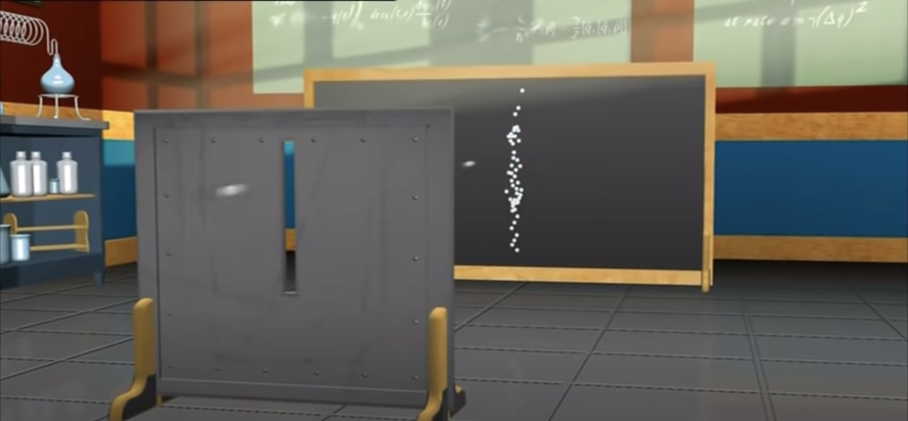
“Now,” he continued, “if we add a second slit, we would expect to see a second band duplicated to the right.”
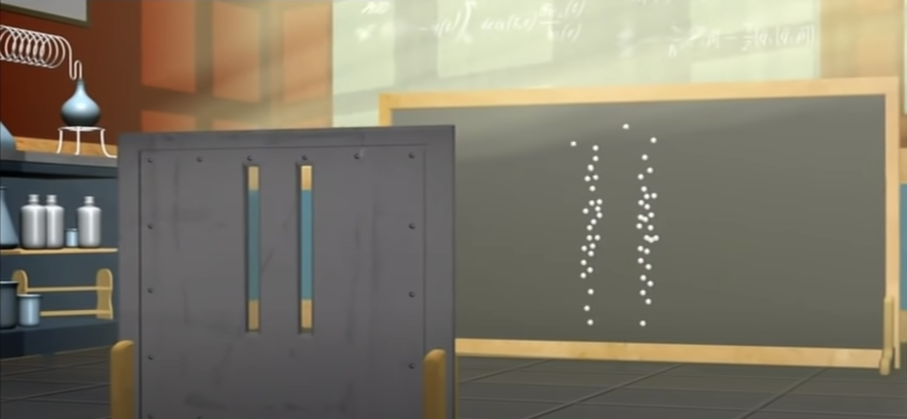
“Now, let’s look at waves.” The marble-shooter machine was replaced by a pool of water. A single large ball was dropped in the water, sending ripples in the direction of the barrier. “The waves hit the slit and radiate out, striking the back wall with the most intensity directly in line with the slit. The line of brightness on the back screen shows that intensity. This is similar to the line the marbles make.”
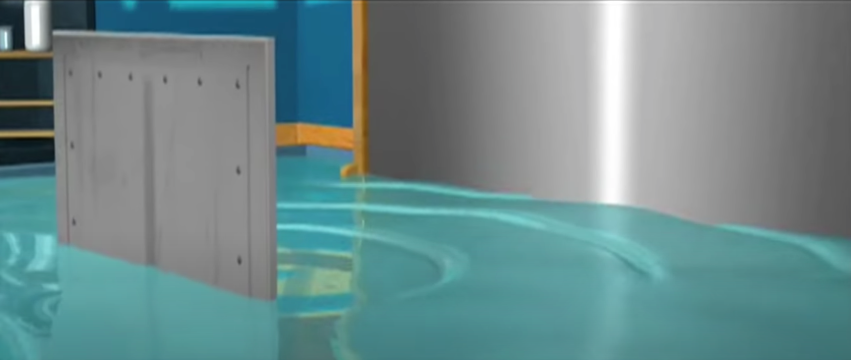
“But when we add the second slit, something different happens. If the top of one wave meets the bottom of another wave, they cancel each other out. So now there’s an interference pattern on the back wall. Places where the two tops meet are the highest intensity (the bright lines), and where they cancel, there is nothing.”
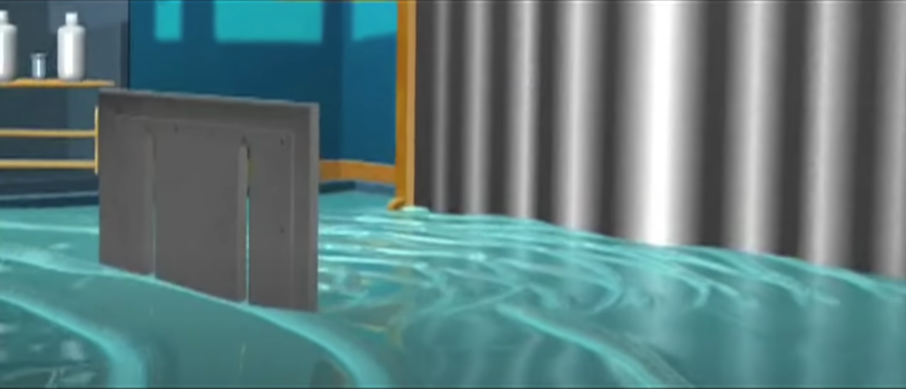
“So, when we throw things (that is, matter) through two slits, we get this: two bands of hits.”
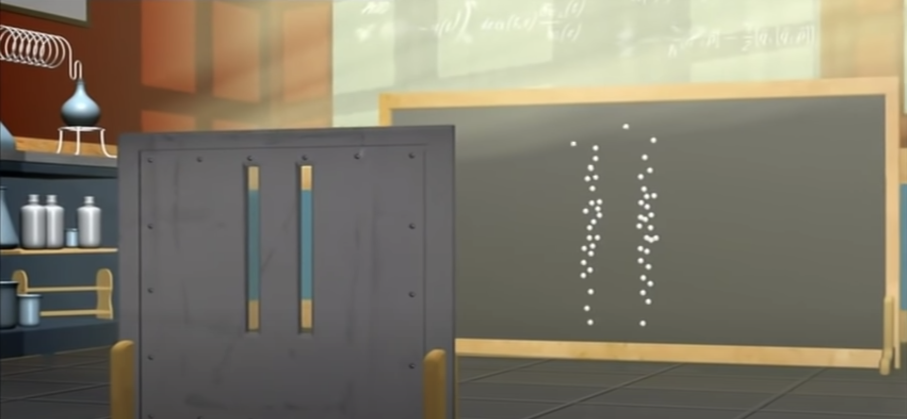
“And with waves, we get an interference pattern of many bands.”
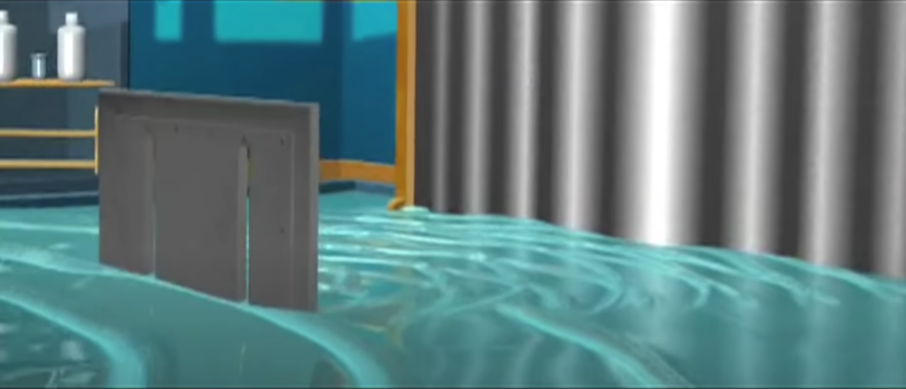
“Good, so far. Now, let’s go quantum!”
The zany cartoon doctor pushed a button on his wristwatch. The entire experiment shrunk down into miniature form.
“An electron,” he continued, “is a tiny, tiny bit of matter — like a marble. Let’s fire a stream through one slit. It behaves just like the marble: a single band.”
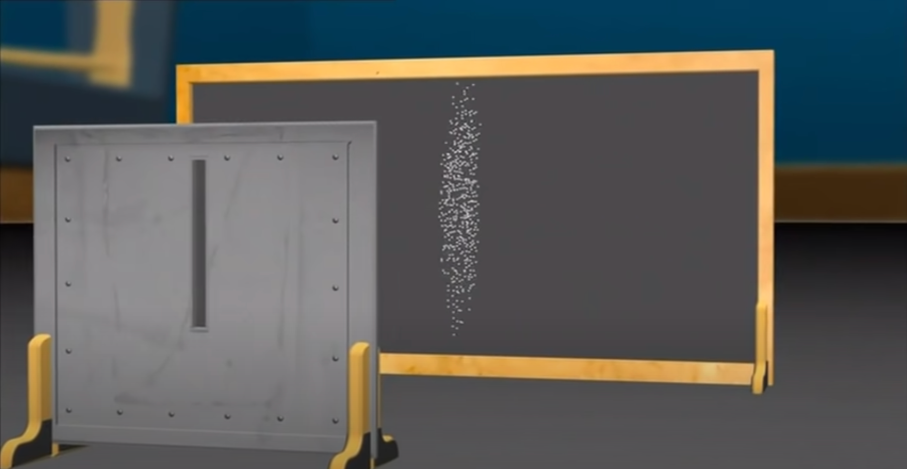
“So if we shoot these tiny bits through two slits, we should get, like the marbles, two bands.”
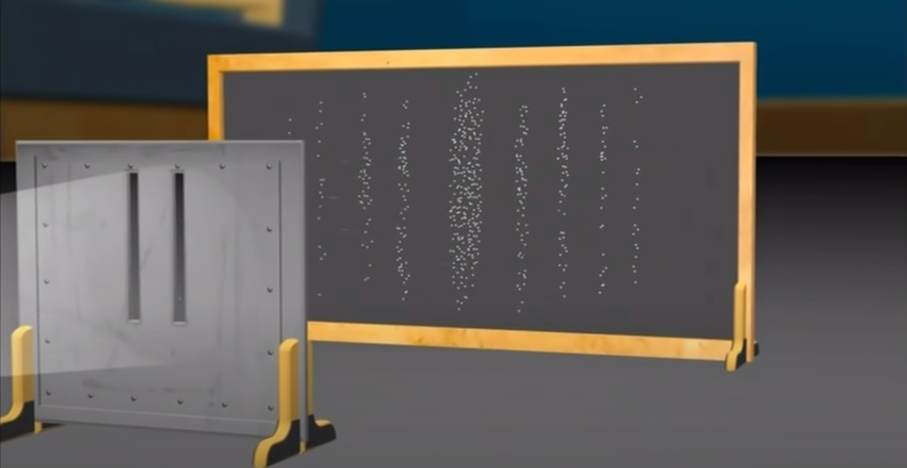
The camera zoomed in as an unexpected sequence of stripes appeared on the black screen. “What?! An interference pattern?! We fired electrons — tiny bits of matter — through, but we got a pattern like waves, not like little marbles. How? How could pieces of matter create an interference pattern like a wave? It doesn’t make sense.
But physicists are clever. They thought maybe those little balls were bouncing off each other and creating that pattern, so they decided to shoot electrons through one at a time. There was no way they could interfere with each other. But after an hour of this, the same interference pattern was seen to emerge.
The conclusion is inescapable! The single electron leaves as a particle, becomes a wave of potentials, goes through both slits and interferes with itself to hit the wall like a particle. But mathematically, it’s even stranger! It goes through both slits, and it goes through neither, and it goes through just one, and it goes through just the other. All of these possibilities are in superposition with each other.
But physicists were completely baffled by this! So they decided to peek and see which slit it actually goes through. They put a measuring device by one slit to see which one it went through, then let it fly. But the quantum world is far more mysterious than they could have imagined. When they observed, the electron went back to behaving like a little marble. It produced a pattern of two bands, not an interference pattern of many. The very act of measuring — or observing which slit it went through — meant it only went through one, not both. The electron decided to act differently, as though it was aware it was being watched. And it was here that physicists stepped forever into the strange never-world of quantum events. What is matter? Marbles or waves? And waves of what? And what does an observer have to do with any of this? The observer collapsed the wave simply by observing…”
The video finished playing.
Zac looked at me in bewilderment. “You mean to say that me observing something changes the behavior of the thing I am observing?”
“Well, no — not quite. This quantum physics stuff often gets bastardized to promote some kind of mystical-spiritual agenda, so we need to be careful to get the scientific facts straight. This has nothing to do with woo, and everything to do with information. Actually, it might be better if I explain it using a different thought experiment called Schrödinger’s cat, which-”
Zac raised his hand.
“Yes?”
“Is that also a porno?” he asked, head tilted to one side. “Although, I guess it would be called Schrödinger’s puss-”
“Zac!” I snapped. “Get your mind out of the gutter and focus! Jesus. You have no filter.”
He shrugged. “Nikki, I’m just the comedic relief here. If you tell the story of this great intellectual adventure one day, you’ll need someone to make the audience laugh, and that happens to be my area of expertise. Otherwise, no one is going to sit through your boring physics lecture.”
I thought about it for a second. I don’t like it when he’s right.
“Hmm…” I mused, stroking my imaginary beard like a wise old man. “You have exposed a deep truth about humanity, Mister Borrowdale. Continue with your smutty jokes. I will allow it.”
“Thank you, kind ma’am.” He took a little bow.
“Okay,” I continued. “Schrödinger’s cat. This was a thought experiment devised by the physicist, Erwin Schrödinger-”
“Really?” Zac asked. “I never would have guessed. Does the experiment, perchance, involve a cat?”
“Why, yes. Yes, it does. Now, Schrödinger thought quantum physics was absolutely absurd. So absurd, that he once said ‘I don’t like it, and I’m sorry I ever had anything to do with it.’”
“Was he referring to your face?”
“No,” I sighed. “He was referring to the weirdness of the quantum world. Plus, he lived ages ago. I think he died in the fifties or sixties or so. He was an Austrian, who-”
“Well I know you like the Austrian men,” Zac interjected. “Didn’t you run off to a Muay Thai training camp in Thailand with a chiseled Austrian God you met in the gym when you were living with me in Colombia? I only met him once. What was his name? Hans? Frans?”
“Actually, I believe you referred to him as ‘Hitler’s wet dream,’ you colossal asshole.”
“Ah yes, you are correct.” Zac stared out the window and into the night sky. “It’s all coming back to me now. Blonde hair, blue eyes, perfect-”
“Zac! Can we please get back on track with this?”
“Fine,” he begrudged.
“Good.” I took another deep breath. “Schrödinger proposed a thought experiment. You take a cat and lock it inside a box with something that can kill the cat — in this case, a radioactive particle with a 50 percent probability of decaying in the next hour and poisoning the cat.
According to physics, when you seal the box, the cat is both alive and dead. It is in what we call a ‘superposition’ of states. But when you actually open the box to check what state the cat is in, you’ll only find it in one particular state — either alive or dead.”
Zac nodded. “Sounds legit. Although, I don’t quite approve of the testing on animals.”
“The key part,” I continued, “is the capturing of information, which is what we call a measurement. As soon as you look inside the box, you are making a measurement. You’re requesting information about the state of the cat. In fact, making a measurement is like asking a question: what is the state of the cat? Until you ask that question, the cat is in all possible states.”
Zac nodded again. “Roger that. The cat is in all possible states until a measurement is made, and then it’s in one particular state.”
“Yes. This Schrödinger’s cat thought experiment follows the same rules as the double-slit experiment-”
“Wink.”
“In the double-slit experiment, if you don’t measure which slit the electron goes through, it will create an interference pattern on the back screen. You will only ever know the probability that the electron will land in a particular spot. It’s the same with the cat. Until you make a measurement, you’ll only ever know the probability that the cat is alive or dead.
But if you do measure which slit the electron goes through, then it will behave like a particle of matter. Once you’ve captured information on its state, it has to be somewhere in particular. It’s the same with the cat. Once you observe the cat, she has to be in a specific state — either alive or dead. Make sense?”

